Paper Menu >>
Journal Menu >>
 A Journal of Software Engineering and Applications, 2012, 5, 187-192 doi:10.4236/jsea.2012.512b036 Published Online December 2012 (http://www.scirp.org/journal/jsea) Copyright © 2012 SciRes. JSEA Formal Modeling and Analysis of AADL Threads in Real Time Maude F. Belala1, M. Benammar1, K. Barkaoui2, A. Hicheur2 1Department of Computer Science, Mentouri University, Constantine, Algeria; 2CEDRIC, Co nservatoire National des Arts et Métiers, Paris, France. Email: b elalafaiza@hotmail.com, Keywords: Architecture Descri ption Language (A DL), AADL thread component, Real Time Maude, Model Checking. kamel.barkaoui@cnam.fr Received 2012 ABSTRACT This pap er presents, without a lterin g the AAD L meta -model, a formal description o f static and behavioral aspects of the AADL thread component. This active and concurrent applicative component of AADL poses many challenges to its formalization and analysis including instantaneous and/or delayed communications, concurrent tasks and time- depen- dent features, and the need to analyze correctness. This formalization, based on real-time object-oriented theories, al- lows not only a p recise description of the se mantics of threads composition with respect to their timing requ i reme nts but also makes po ssible the formal verifica tion of behavioral properties. 1. Introduction The problem of ensuring as early as possible the cor- rectness of a software architecture (SA) is of great im- portance in the develop ment life-cycle of software prod- ucts. Recently, model checking, that is completely auto- matic, allows developers to perform exhaustive verifica- tion of the SA (as for e.g. [1]). In this pap er, we will use this technique to assess whether an SA specification noted in AADL language satisfies desired architectural properties. The architecture description language AADL (Archi- tecture Analysis and Design Language) [2] is a formal notation for describing the architectural plan of real time embedded system at various abstraction levels. It offers the capacity to assembly both information concer ni ng t he application structure and its deployment. However, AADL is focused on the architectural as- pects of the system components and their connections, but doesn’t deal directly with their behavioral aspects. Thus, the formal reasoning on AADL architecture or its formal analysis poses a set of challenges, including: 1) Modeling concurrent and distributed components of AADL architecture, 2) Modeling components communi- cation with transmission delays, 3) Modeling time-dependent behaviors, and 4) Analyzing behavior properties with respect of AADL declared constraints. Several works are being done in literature tempting to formalize AADL architectural description while trans- forming it to o ther formal mode ls. These models are pro- vided on the basis of some well known formalisms such as, timed automaton, timed Petri nets (TPN), real time process algebra (ACSR) or timed abstract state machine (TASM), that come with some convenient tools (TINA [5], CADP [6], etc.). Others more practical works are also raised; a translation from VTS (Visual Timed event Scenarios) to Time Petri Nets in [9] enables the mod- el-checking of properties expressed in VTS over AADL models using TPN-based tools. Nevertheless, most of these co ntributions have focused on detecting deadlocks states or on concurrent access control to shared data, they have been interested by formalization of only some AADL concepts. This paper shows how we can met all the cited chal- lenges by extending the semantic framework ABAReL annex proposed in [2] and based on rewriting logic. Our extension consists in defining the behavior specification of the fundamental concurrent AADL execution unit Thread as a real-time re write theory ℜ T = (ΣT, ET, LT, RT). The membership equational theory (ΣT, ET) describes all declared elements in the AADL thread description (flo ws, properties, etc.). The labeled rewrite rules (LT, RT), in- stantaneous and tick ones, describe the thread behavior according to its configurations evolution, taking into account its local states and those of its connection ports, as well as its declared timing requirements. In addition, proof of generic and crucial architectural properties (such 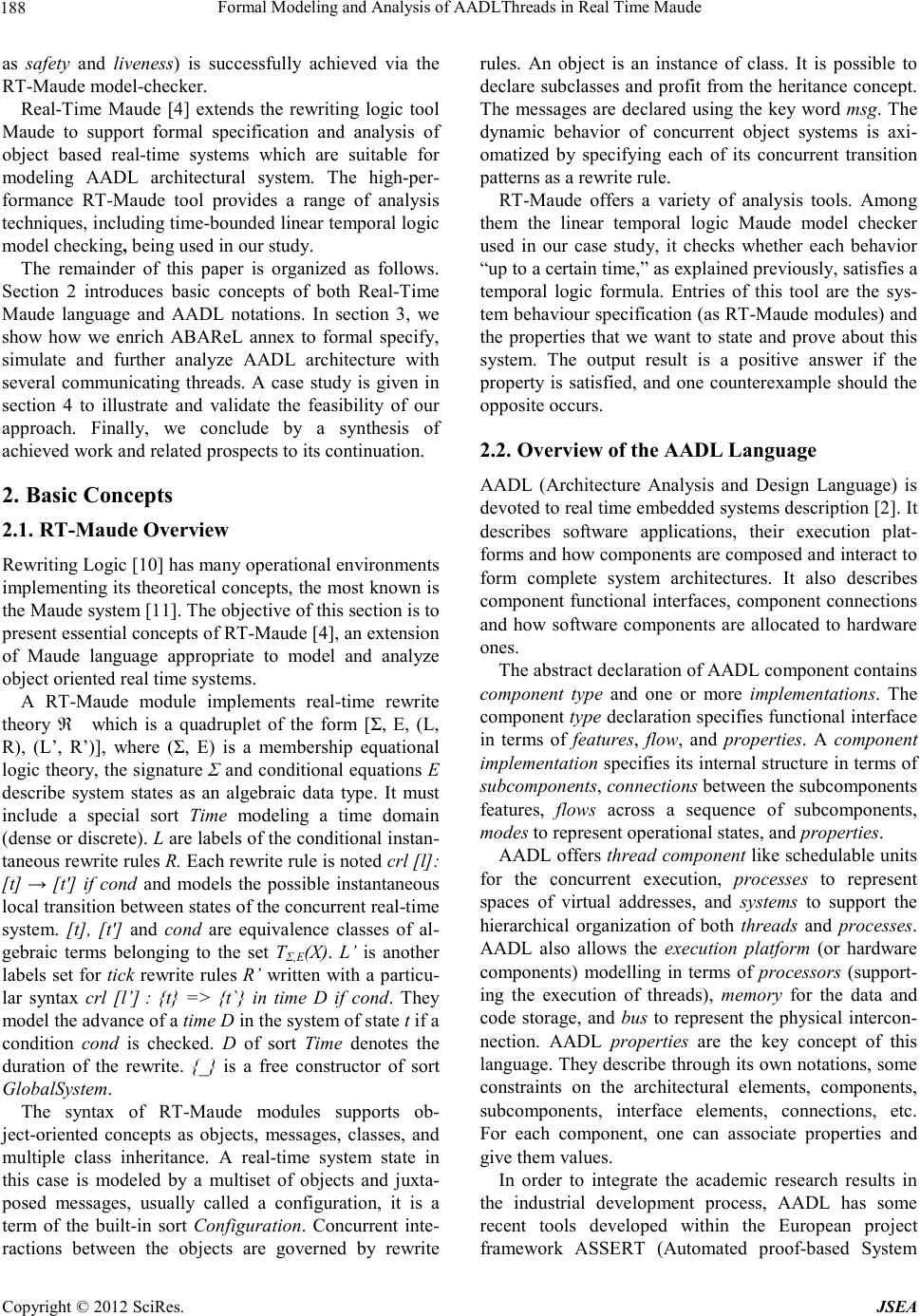 Formal Modeling and Analysis of AADLThreads in Real Time Maude Copyright © 2012 SciRes. JSEA 188 as safety and liveness) is successfully achieved via the RT-Maude model-checker. Real-Time Maude [4] extends the rewriting logic tool Maude to support formal specification and analysis of object based real-time systems which are suitable for modeling AADL architectural system. The high-per- formance RT-Maude tool provides a range of analysis techn ique s, i nclud ing t ime -bounded linear temporal lo gic model checking, being used in our study. The remainder of this paper is organized as follows. Section 2 introduces basic concepts of both Real-Time Maude language and AADL notations. In section 3, we show how we enrich ABAReL annex to formal specify, simulate and further analyze AADL architecture with several communicating threads. A case study is given in section 4 to illustrate and validate the feasibility of our approach. Finally, we conclude by a synthesis of achieved work and related prospects to its continuation. 2. Basic Concepts 2.1. RT-Maude Overview Rewriting Logic [10] has many operational environments implementin g its theoretical concepts, the most kno wn is the Maude syste m [11]. T he obje ctive of this section is to present essential concepts of RT-Maude [4], an extension of Maude language appropriate to model and analyze object o riented real time syste ms. A RT-Maude module implements real-time rewrite theory ℜ which is a quadruplet of the form [Σ, E, (L, R), (L’, R’)], where (Σ, E) is a membership equational logic theor y, the signat ure Σ and conditional equations E describe system states as an algebraic data type. It must include a special sort Time modeling a time domain (dense or discrete). L are labels o f the c onditional instan- taneous rewrite rules R. Each re write rule is noted crl [l]: [t] → [t'] if cond and models the possible instantaneous local transition betwee n states of the concurr ent real-time system. [t], [t'] and cond are equivalence classes of al- gebraic terms belonging to the set TΣ,E(X). L’ is another labels set for tick rewrite rules R’ written with a particu- lar syntax crl [l’] : {t} => {t`} in time D if cond. They model the advance of a time D in the system of state t if a condition cond is checked. D of sort Time denotes the duration of the rewrite. {_} is a free constructor of sort GlobalSystem. The syntax of RT-Maude modules supports ob- ject-oriented concepts as objects, messages, classes, and multiple class inheritance. A real-time system state in this case is modeled by a multiset of objects and juxta- posed messages, usually called a configuration, it is a term of the built-in sort Configuration. Concurrent inte- ractions between the objects are governed by rewrite rules. An object is an instance of class. It is possible to declare subclasses and profit from the heritance concept. The messages are declared using the key word msg. The dynamic behavior of concurrent object systems is axi- omatized by specifying each of its concurrent transition patterns as a rewrite rule. RT-Maude offers a variety of analysis tools. Among them the linear temporal logic Maude model checker used in our case study, it checks whether each behavior “up to a certain time,” as explained previously, satisfies a temporal logic formula. Entries of this tool are the sys- tem behaviour specification (as RT-Maude modules) and the properties that we want to state and prove about this system. The output result is a positive answer if the property is satisfied, and one counterexample should the opposite occurs. 2.2. Overview of the AADL Language AADL (Architecture Analysis and Design Language) is devoted to real time embedded systems description [2]. I t describes software applications, their execution plat- forms and how components are composed and interact to form complete system architectures. It also describes component functional interfaces, component connections and how software components are allocated to hardware ones. The abstract declaration of AADL component contains component type and one or more implementatio n s. The component type declaration specifies functio nal interface in terms of features, flow, and properties. A component implementation specifies its inter nal str uctur e in ter ms of subcomponents, connections betwee n t he sub c o mponent s features, flows across a sequence of subcomponents, modes to repr esent operational states, and properties. AADL offers thread component like schedulable units for the concurrent execution, processes to represent spaces of virtual addresses, and systems to support the hierarchical organization of both threads and processes. AADL also allows the execution platform (or hardware components) modelling in terms of proc essors (support- ing the execution of threads), memory for the data and code storage, and bus to represent the physical intercon- nection. AADL properties are the key concept of this langua ge. T hey desc ribe throu gh its o wn notati ons, s ome constraints on the architectural elements, components, subcomponents, interface elements, connections, etc. For each component, one can associate properties and give them values . In order to integrate the academic research results in the industrial development process, AADL has some recent tools developed within the European project framework ASSERT (Automated proof-based System 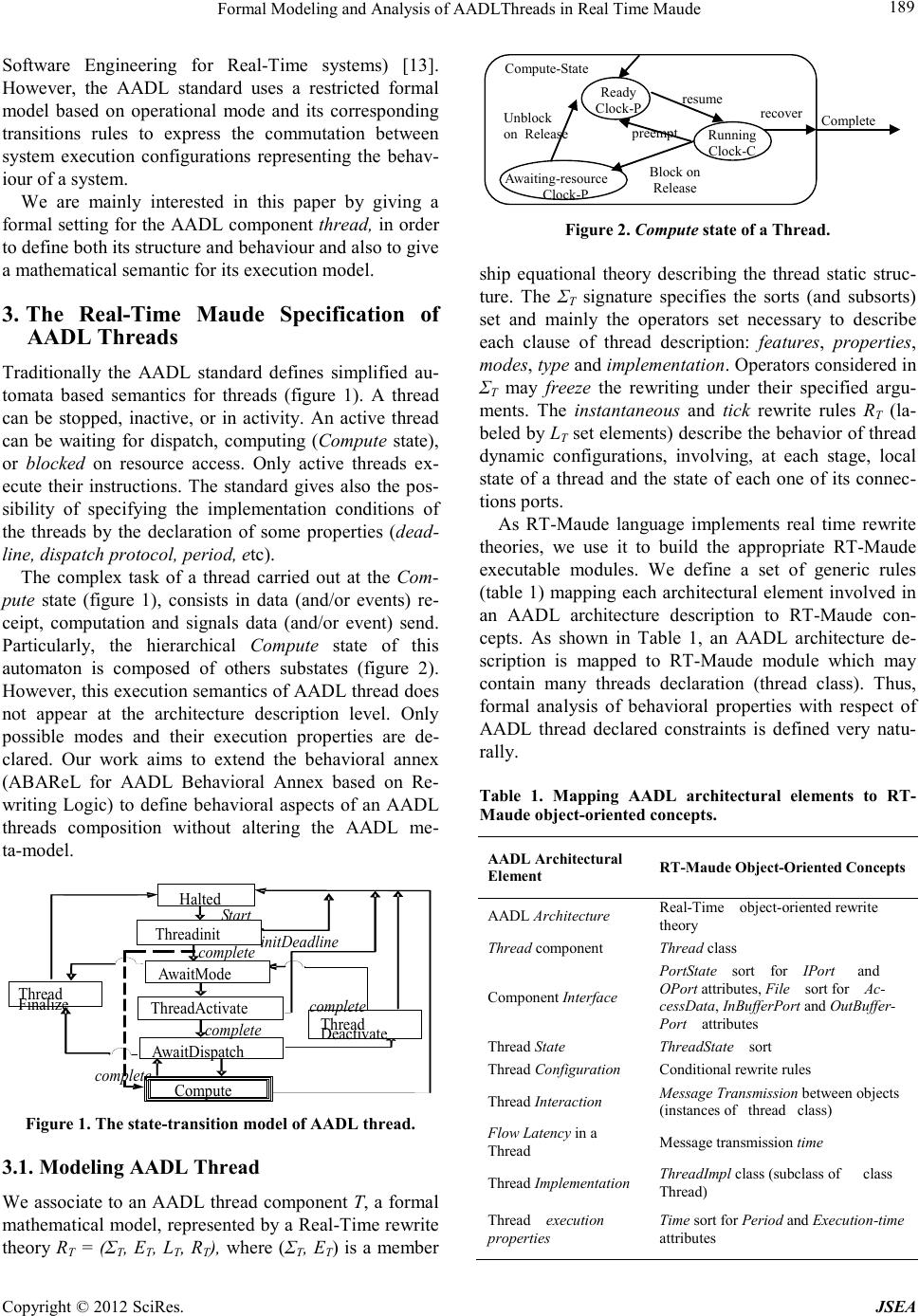 Formal Modeling and Analysis of AADLThreads in Real Time Maude Copyright © 2012 SciRes. JSEA 189 Software Engineering for Real-Time systems) [13]. However, the AADL standard uses a restricted formal model based on operational mode and its corresponding transitions rules to express the commutation between system execution configurations representing the behav- iour of a system. We are mainly interested in this paper by giving a formal setting for the AAD L component thread, in order to define both its structure and behavio ur and a lso to give a mathematical semantic for its execution model. 3. The Real-Time Maude Specification of AADL Threads Traditionally the AADL standard defines simplified au- tomata based semantics for threads (figure 1). A thread can be stopped, inactive, or in activity. An active thread can be waiting for dispatch, computing (Compute state), or blocked on resource access. Only active threads ex- ecute their instructions. The standard gives also the pos- sibility of specifying the implementation conditions of the threads by the declaration of some properties (dead- line, dispatch protocol, period, etc). The complex task of a thread carried out at the Com- pute state (figure 1), consists in data (and/or events) re- ceipt, computation and signals data (and/or event) send. Particularly, the hierarchical Compute state of this automaton is composed of others substates (figure 2). Ho wever, this e xec utio n se mant ics o f AAD L thr ead do es not appear at the architecture description level. Only possible modes and their execution properties are de- clared. Our work aims to extend the behavioral annex (ABAReL for AADL Behavioral Annex based on Re- writing Logic) to define behavioral aspects of an AADL threads composition without altering the AADL me- ta-model. St a rt Halted Threadinit AwaitMode ThreadActivate AwaitDispatch Thread Deactivate Thread Finalize complete complete complete complete initDeadline Compute Figure 1 . The state-transition model of AADL thread. 3.1. Modeling AADL Thread We associate to an AADL thread component T, a for ma l mathematical model, represented by a Real-Time re write theory RT = (ΣT, ET, LT, RT), where (ΣT, ET) is a member recover Ready Clock-P Running Clock-C Awaiting-resource Clock-P Compute-State resume preempt Block on Release Unblock on Release Complete Figure 2 . Compute state of a Thread. ship equational theory describing the thread static struc- ture. The ΣT signature specifies the sorts (and subsorts) set and mainly the operators set necessary to describe each clause of thread description: features, properties, modes, type and implem entation . Op erators considered in ΣT may free ze the rewriting under their specified argu- ments. The instantaneous and tick rewrite rules RT (la- beled by LT set elements) describe the behavior of thread dynamic configurations, involving, at each stage, local state of a thread and the state of each one of its connec- tions ports. As RT-Maude language implements real time rewrite theories, we use it to build the appropriate RT-Maude executable modules. We define a set of generic rules (table 1) mapping each architectural element involved in an AADL architecture description to RT-Maude con- cepts. As shown in Table 1, an AADL architecture de- scription is mapped to RT-Maude module which may contain many threads declaration (thread class). Thus, formal analysis of behavioral properties with respect of AADL thread declared constraints is defined very natu- rally. Table 1. Mapping AADL architectural elements to RT- Maude object-oriented concepts. AADL Arch itectural Element RT-Maude Object-Oriented Concepts AADL Ar chitecture Real-Time object-oriented rewrite theory Thread component Thread class Component Interface PortState sort for IPort and OPort attributes, File sort for Ac- cessData, InBufferPort and OutBuffer- Port attributes Thread State ThreadState sort Thread Configuration Conditional rewrite rules Thread Interac tion Message Transmission between objects (instances of thread class) Flow Latency in a Thread Message transmission time Thread Implementation ThreadImpl class (subclass of class Thread) Thread execution properties Time sort for Period and Execution-time attributes 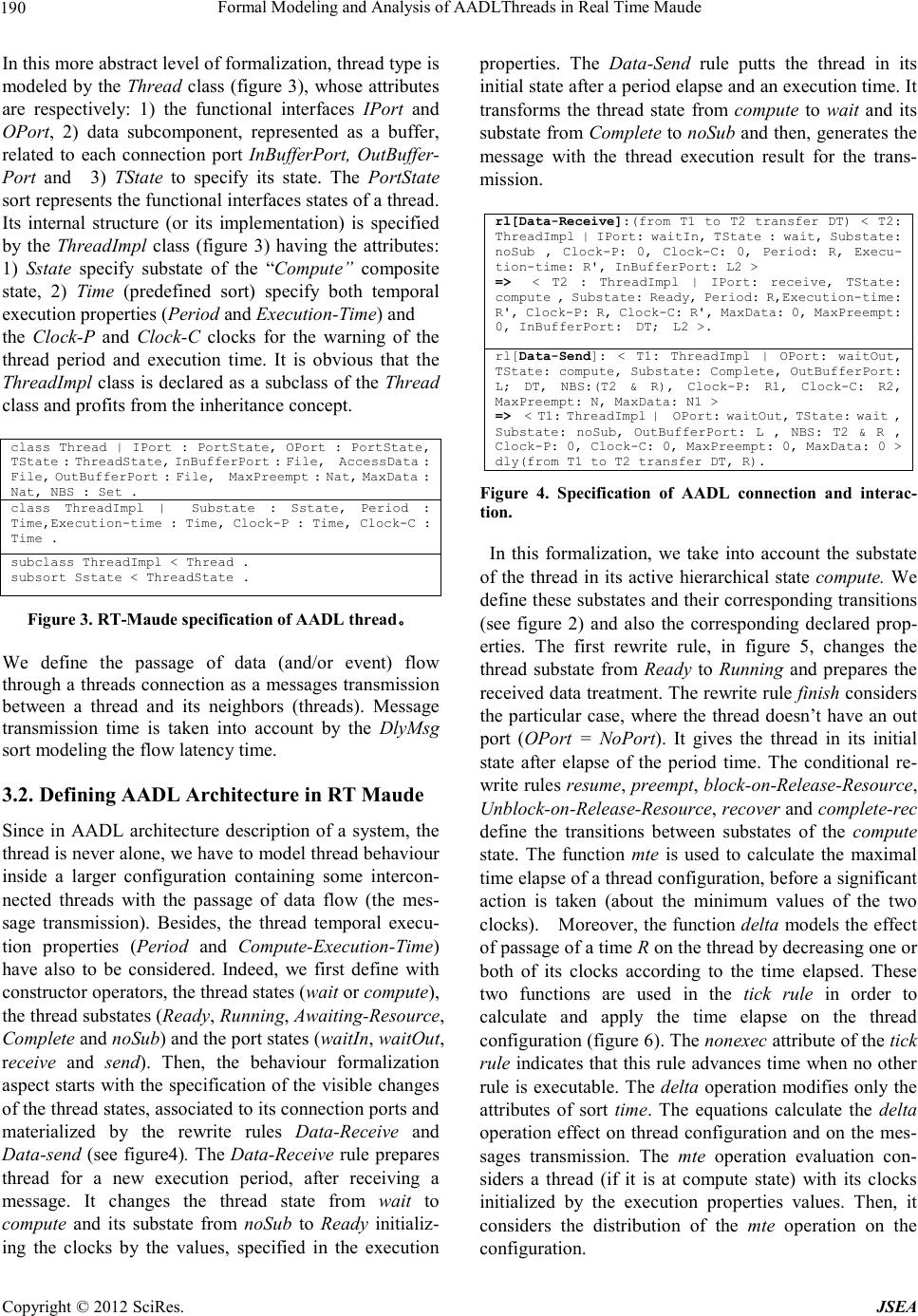 Formal Modeling and Analysis of AADLThreads in Real Time Maude Copyright © 2012 SciRes. JSEA 190 In this more abstract level of f o r malization, thread type is modeled by the Thread class (figure 3), whose attributes are respectively: 1) the functional interfaces IPort and OPort , 2) data subcomponent, represented as a buffer, related to each connection port InBufferPort, OutBuffer- Port and 3) TState to specify its state. The PortState sort represents the functional interfaces states of a thread. Its internal structure (or its implementation) is specified by the ThreadImpl class (figure 3) having the attributes: 1) S sta te specify substate of the “Compute” composite state, 2) Time (predefined sort) specify both temporal execution properties (Period and Execution-Time ) and the Clock-P and Clock- C clocks for the warning of the thread period and execution time. It is obvious that the ThreadImpl class is declared as a subclass of the Thread class and profits fro m the inheritance concept. class Thread | IPort : PortState, OPort : PortState, TState : ThreadState, InBufferPort : File, AccessData : File, OutBufferPort : File, MaxPreempt : Nat, MaxData : Nat, NBS : Set . class ThreadImpl | Substate : Sstate, Period : Time,Execution-time : Ti me, C lock-P : Time, Clock-C : Time . subclass ThreadImpl < Thread . subsort Sstate < ThreadState . Figure 3 . RT-Maude specification of AADL thread。 We define the passage of data (and/or event) flow through a threads connection as a messages transmission between a thread and its neighbors (threads). Message transmission time is taken into account by the DlyMsg sort modeling the flow latency time. 3.2. Defining AADL Architecture in RT Maude Since in AADL architecture description of a system, the thread is never alone, we have to model thread behaviour inside a larger configuration containing some intercon- nected threads with the passage of data flow (the mes- sage transmission). Besides, the thread temporal execu- tion properties (Period and Compute-Execution-Time) have also to be considered. Indeed, we first define with constructor operator s, the thread states (wait or compute), the thread substat es ( Ready, Running, Awaiting-Resource, Complete and noSub) and the port states (waitIn , waitOut, receive and send). Then, the behaviour formalization aspect starts with the sp ecific ation of the visible changes of the thread states, associated to its connec ti on p o r ts a nd materialized by the rewrite rules Data-Receive and Data-send (see figure4) . The Data-Receive rule prepares thread for a new execution period, after receiving a message. It changes the thread state from wait to compute and its substate from noSub to Ready initializ- ing the clocks by the values, specified in the execution properties. The Data-Send rule putts the thread in its initial state after a period elapse and an execution time. It transforms the thread state from compute to wait and its substa te from Complete to noSub and then, genera tes the message with the thread execution result for the trans- mission. rl[Data-Receive]:(from T1 to T2 transfer DT) < T2: ThreadImpl | IPort: waitIn, TState : wait, Substate: noSub , Clock-P: 0, Clock-C: 0, Period: R, Execu- tion-time: R', InBufferPort: L2 > => < T2 : ThreadImpl | IPort: receive, TState: compute , Substate: Ready, Period: R,Execution-time: R', Clock-P: R, Clock-C: R', MaxData: 0, MaxPreempt: 0, InBufferPort: DT; L2 >. rl[Data-Send]: < T1: ThreadImpl | OPort: waitOut, TState: compute, Substate: Complete, OutBufferPort: L; DT, NBS:(T2 & R), Clock-P: R1, Clock- C: R2, MaxPreempt: N, MaxData: N1 > => < T1: ThreadImpl | OPort: waitOut, TState: wait , Substate: noSub, OutBufferPort: L , NBS: T2 & R , Clock-P: 0, Clock-C: 0, MaxPreempt: 0, MaxData: 0 > dly(from T1 to T2 transfer DT, R). Figure 4. Specification of AADL connection and interac- tion. In this formalization, we take into account the substate of the thread in its active hierarchical state compute. We define these substa tes a nd the ir co rrespo nding tr ansitions (see figure 2) and also the corresponding declared prop- erties. The first rewrite rule, in figure 5, changes the thread substate from Ready to Running and prepares the received data treatment. The rewrite rule fin ish considers the particular case, where the thread doesn’t have an out port (OPort = NoPort). It gives the thread in its initial state after elapse of the period time. The conditional re- write rule s resume, preempt, block-on-Release-Re s ource, Unblock-on-Release-Resource, recover and complete-rec define the transitions between substates of the compute state. The function mte is used to calculate the maximal time elapse of a thread configuration, before a significant action is taken (about the minimum values of the two clocks). Moreover, the function delta models the effect of passage of a time R on the thread by decreasing one or both of its clocks according to the time elapsed. These two functions are used in the tick rule in order to calculate and apply the time elapse on the thread confi gur atio n (fi gur e 6). The nonexec attribute o f the tick rule indicates that th is rule advances time whe n no o ther rule is executable. The delta operation modifies only the attributes of sort time . The equations calculate the delta operation effect on thread configuration and on the mes- sages transmission. The mte operation evaluation con- siders a thread (if it is at compute state) with its clocks initialized by the execution properties values. Then, it considers the distribution of the mte operation on the configuration. 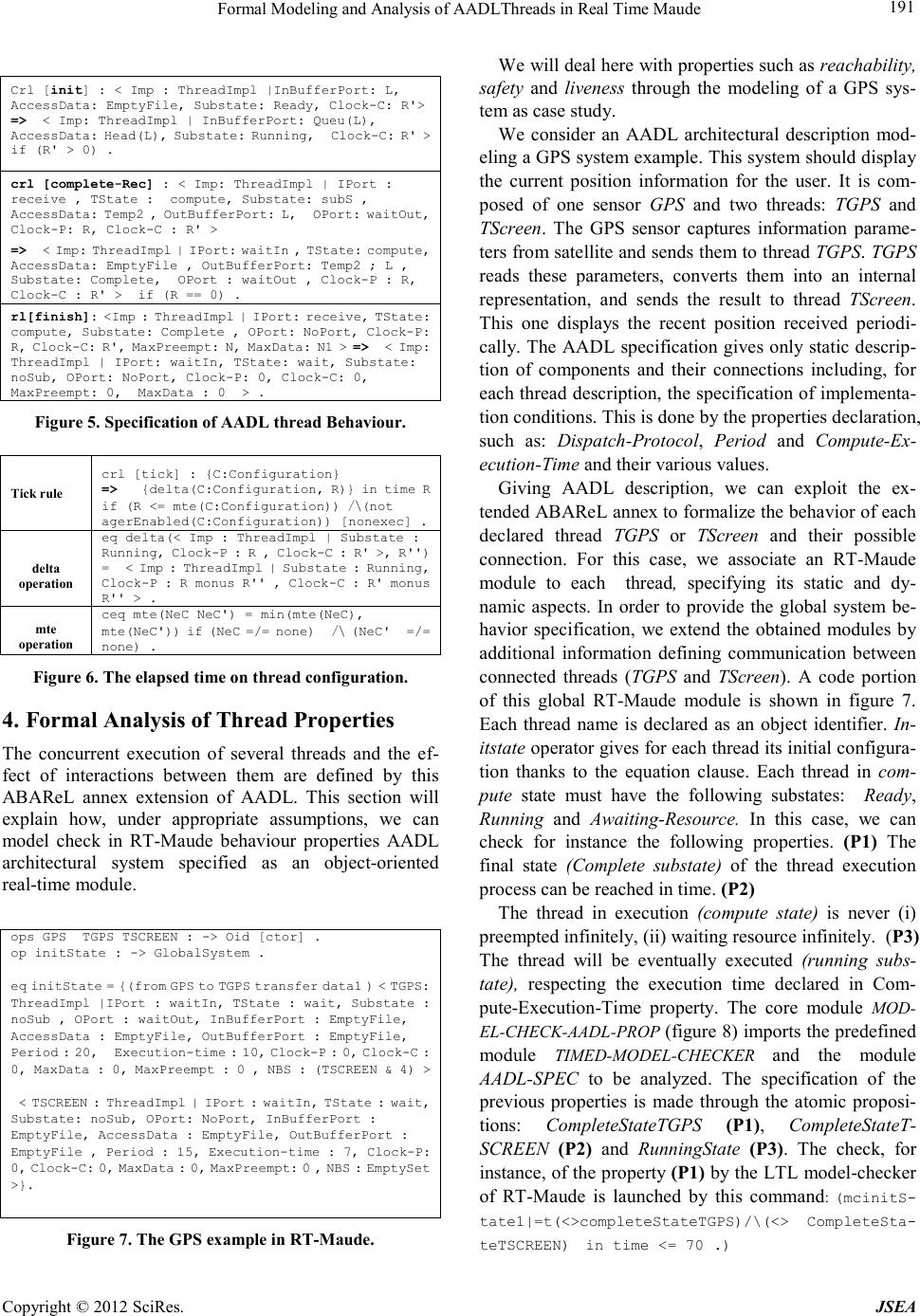 Formal Modeling and Analysis of AADLThreads in Real Time Maude Copyright © 2012 SciRes. JSEA 191 Crl [init] : < Imp : ThreadImpl |InBufferPort: L, AccessData: EmptyFile, Substate: Ready, Clock-C: R'> => < Imp: ThreadImpl | InBufferPort: Queu(L), AccessData: Head(L), Substate: Running, Clock-C: R' > if (R' > 0) . crl [complete-Rec] : < Imp: ThreadImpl | IPort : receive , TState : compute, Substate: subS , AccessData: Temp2 , OutBufferPort: L, OPort: waitOut, Clock-P: R, Clock-C : R' > => < Imp: ThreadImpl | IPort: waitIn , TState: compute, AccessData: EmptyFile , OutBufferPort: Temp2 ; L , Substate: Complete, OPort : waitOut , Clock-P : R, Clock-C : R' > if (R == 0) . rl[finish]: <Imp : ThreadImpl | IPort: receive, TState: compute, Substate: Complete , OPort: NoPort, Clock-P: R, Clock-C: R', MaxPreempt: N, MaxData: N1 > => < Imp: ThreadImpl | IPort: waitIn, TState: wait, Substate: noSub, OPort: NoPort, Clock-P: 0, Clock-C: 0, MaxPreempt: 0, MaxData : 0 > . Figure 5. Specification of AADL thread Behaviour. Tick rule crl [tick] : {C:Configuration} => {delta(C:Configuration, R)} in time R if (R <= mte(C:Configuration)) /\(not agerEnabled(C:Configuration)) [nonexec] . delta operation eq delta(< Imp : ThreadImpl | Substate : Running, Clock-P : R , Clock-C : R' >, R'') = < Imp : ThreadImpl | Substate : Running, Clock-P : R monus R'' , Clock-C : R' monus R'' > . mte operation ceq mte(NeC NeC') = min(mte(NeC), mte(NeC')) if (NeC =/= none) /\ (NeC' =/= none) . Figure 6. The elapsed time on thre ad configuration. 4. Formal Analysis of Thread Properties The concurrent execution of several threads and the ef- fect of interactions between them are defined by this ABAReL annex extension of AADL. This section will explain how, under appropriate assumptions, we can model check in RT-Maude behaviour properties AADL architectural system specified as an object-oriented real-time module. ops GPS TGPS TSCREEN : -> Oid [ctor] . op initState : -> GlobalSystem . eq initState = {(from GPS to TGPS transfer data1 ) < TGPS: ThreadImpl |IPort : waitIn, T State : wait, Substate : noSub , OPort : waitOut, InBufferPort : EmptyFile, AccessData : EmptyFile, OutBufferPort : EmptyFile, Period : 20, Execution-time : 10, Clock-P : 0, Clock-C : 0, MaxData : 0, MaxPreempt : 0 , NBS : (T SCREEN & 4) > < TSCREEN : ThreadImpl | IPort : waitIn, TState : wait, Substate: noSub, OPort: NoPort, InBufferPort : EmptyFile, AccessData : EmptyFile, OutBufferPort : EmptyFile , Period : 15, Exec ution-time : 7, Clock-P: 0, Clock-C: 0, MaxData : 0, MaxPreempt: 0 , NBS : EmptySet >}. Figure 7 . The GPS example in RT-Ma ude. We will deal here with properties such as reachability, safety and liveness through the modeling of a GPS sys- tem as case study. We consider an AADL architectural description mod- eling a GP S syst em example. T his sys te m sho uld disp la y the current position information for the user. It is com- posed of one sensor GPS and two threads: TGP S and TScreen. The GPS sensor captures information parame- ters from satellite a nd send s the m to thr ead TGPS. TGPS reads these parameters, converts them into an internal representation, and sends the result to thread TScreen. This one displays the recent position received periodi- cally. The AADL specification give s only stat ic descrip- tion of components and their connections including, for each thread description, the specification of implementa- tion condition s. This is done b y the properties declaration, such as: Dispatch -Protocol, Period and Compute-Ex- ecution -Time a nd their various values. Giving AADL description, we can exploit the ex- tended ABAReL annex to formalize the behavior of each declared thread TGPS or TScreen and their possible connection. For this case, we associate an RT-Maude module to each thread, specifying its static and dy- namic aspects. In order to provide the global system be- havior specification, we extend the obtained modules by additional information defining communication between connected threads (TGPS and TScreen). A code portion of this global RT-Maude module is shown in figure 7. Each thread name is declared as an object identifier. In- itstate oper ator gives for e ach thread its i nitial co nfigura- tion thanks to the equation clause. Each thread in com- pute state must have the following substates: Ready, Running and Awaiting-Resource. In this case, we can check for instance the following properties. (P1) The final state (Complete substate) of the thread execution process can be reached in time. (P2) The thread in execution (compute state) is never (i) preempted infinitely, (ii) waiting resource infinitely. (P3) The thread will be eventually executed (running subs- tate), respecting the execution time declared in Com- pute-Execution-Time property. The core module MOD- EL-CHECK-AADL-PROP (figure 8) impo rts the predefined module TIMED -MODEL -CHECKER and the module AADL-SPEC to be analyzed. The specification of the previous properties is made through the atomic proposi- tions: CompleteS ta te TGPS (P1), CompleteStateT- SCREEN (P2) and RunningState (P3). The check, for instance, of t he property (P1) by the LTL model-checker of RT-Maude is launched by this command: (mcinitS- tate1|=t(<>completeStateTGPS)/\(<> CompleteSta- teTSCREEN) in time <= 70 .) 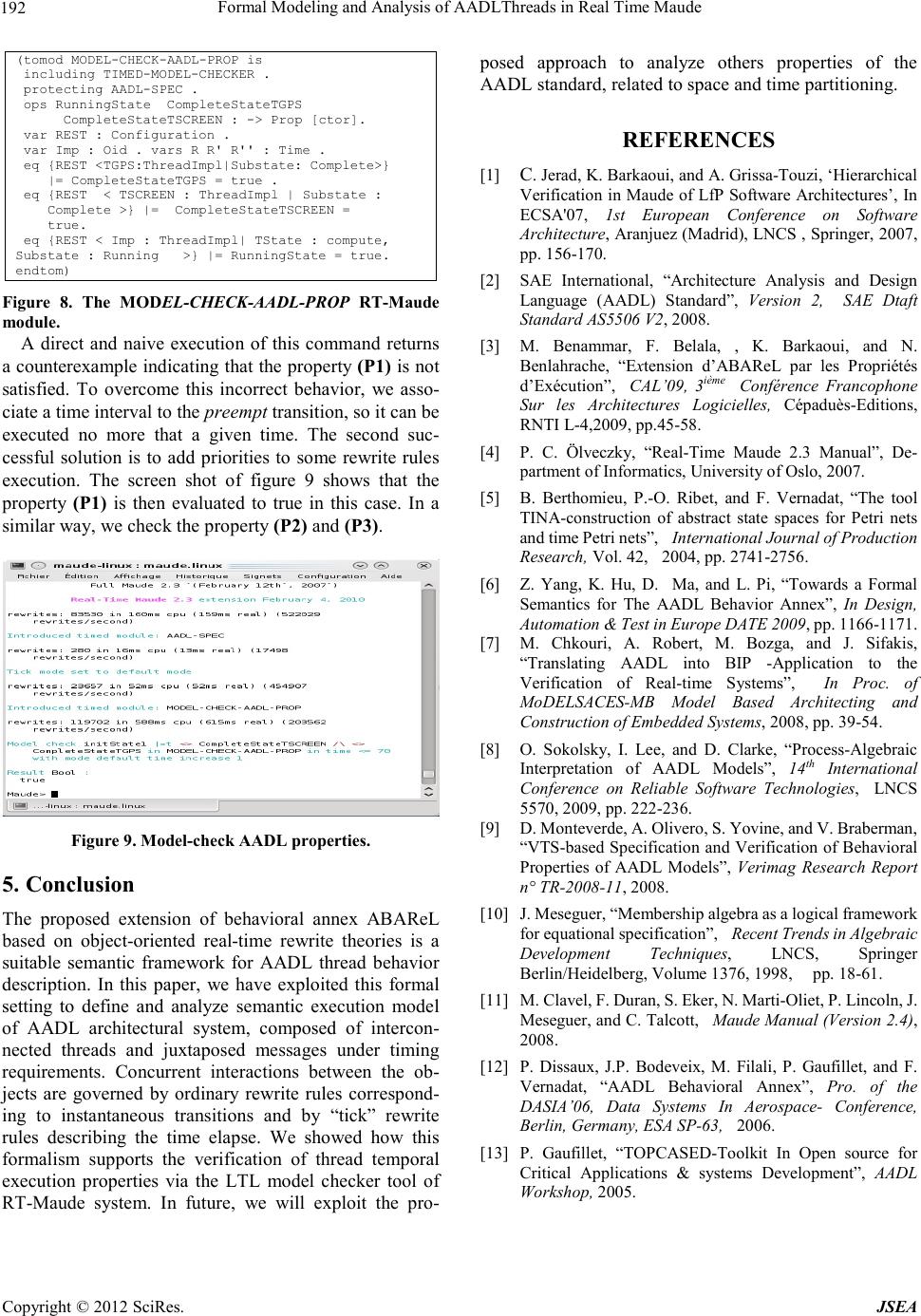 Formal Modeling and Analysis of AADLThreads in Real Time Maude Copyright © 2012 SciRes. JSEA 192 (tomod MODEL-CHECK-AADL-PROP is including TIMED-MODEL-CHECKER . protecting AADL-SPEC . ops RunningState CompleteStateTGPS CompleteStateTSCREEN : -> Prop [ctor]. var REST : Configuration . var Imp : Oid . vars R R' R'' : Time . eq {REST <TGPS:ThreadImpl|Substate: Complete>} |= CompleteStateTGPS = true . eq {REST < TSCREEN : ThreadImpl | Substate : Complete >} |= CompleteStateTSCREEN = true. eq {REST < Imp : ThreadImpl| TState : compute, Substate : Running >} |= RunningState = true. endtom) Figure 8. The MODEL-CHECK-AADL-PROP RT-Maude module. A direct and naive execution of this command returns a counterexample indicating that the property (P1) is not satisfied. To overcome this incorrect behavior, we asso- ciate a time interval to t he preempt tr a nsition, so it can be executed no more that a given time. The second suc- cessful solution is to add priorities to some rewrite rules execution. The screen shot of figure 9 shows that the property (P1) is then evaluated to true in this case. In a similar way, we check t he property (P2) and (P3). Figure 9. Model-check AADL properties. 5. Conclusion The proposed extension of behavioral annex ABAReL based on object-oriented real-time rewrite theories is a suitable semantic framework for AADL thread behavior descriptio n. In this paper, we have exploited this formal setting to define and analyze semantic execution model of AADL architectural system, composed of intercon- nected threads and juxtaposed messages under timing require ments. Concurrent interactions between the ob- jects are governed by ordinary rewrite rules correspond- ing to instantaneous transitions and by “tick” rewrite rules describing the time elapse . We showed how this formalism supports the verification of thread temporal execution properties via the LTL model checker tool of RT-Maude system. In future, we will exploit the pro- posed approach to analyze others properties of the AADL standard, related to space and ti me partitioning. REFERENCES [1] C. Jerad , K. Barkao ui , an d A. Gri ssa-Tou zi, ‘Hi erarch ical Verification in Maude of LfP Software Architectures’, In ECSA'07, 1st European Conference on Software Architecture, Aranjuez (Madrid), LNCS , Springer, 2007, pp. 156-170. [2] SAE International, “Architecture Analysis and Design Language (AADL) Standard”, Version 2, SAE Dtaft Standard AS5506 V2, 2008. [3] M. Benammar, F. Belala, , K. Barkaoui, and N. Benlahrache, “Extension d’ABAReL par les Propriétés d’Exécution”, CAL’09, 3ième Conférence Francophone Sur les Architectures Logicielles, Cépad uès-Editions, RNTI L-4,2009, pp.45-58. [4] P. C. Ölveczky, “Real-Time Maude 2.3 Manual”, De- partment of Informatics, University of Oslo, 2007. [5] B. Berthomieu, P.-O. Ribet, and F. Vernadat, “The tool TINA-construction of abstract state spaces for Petri nets and time Petri nets”, Internation al Journ al of Producti o n Research, Vol. 42, 2004, pp. 27 41-2756. [6] Z. Yang, K. Hu, D. Ma, and L. Pi, “Towards a Formal Semantics for The AADL Behavior Annex”, In Design, Autom ati o n & Te s t in Euro pe D ATE 20 09, pp. 1166-1171. [7] M. Chkouri, A. Robert, M. Bozga, and J. Sifakis, “Translating AADL into BIP -Application to the Verification of Real-time Systems”, In Proc. of MoDELSACES-MB Model Based Architecting and Constr uc tion of Embe d de d Sy s t e m s , 2008, pp. 39-54. [8] O. Sokolsky, I. Lee, and D. Clarke, “Proces s-Algebraic Interpretation of AADL Models”, 14th International Conference on Reliable Software Technologies, LNCS 5570, 2009, pp. 222-236. [9] D. Monteverde, A. Olivero, S. Yovine, and V. Braberman, “V TS-based S pecification an d Verificatio n of Behavioral Properties of AADL Models”, Verimag Research Report n° TR-2008-11, 2008. [10] J. Meseguer, “Membership algebra as a logical framework for equational specification”, Recent Tre nds in A lge brai c Development Techniques, LNCS, Springer Berlin/Heidelberg, Volume 1376, 1998, pp. 18-61. [11] M. Clavel, F. Dura n, S. E ker, N . Marti-Olie t, P. L incoln, J . Meseguer, and C. Talcott, Maude Manual (Version 2.4), 2008. [12] P. Dissaux, J.P. Bodeveix, M. Filali, P. Gaufillet, and F. Vernadat, “AADL Behavioral Annex”, Pro. of the DASIA’06, Data Systems In Aerospace- Conference, Berlin, Germany, ESA SP-63, 2006. [13] P. Gaufillet, “TOPCASED-Toolkit In Open source for Critical Applications & systems Development”, AADL Workshop, 2005. |

